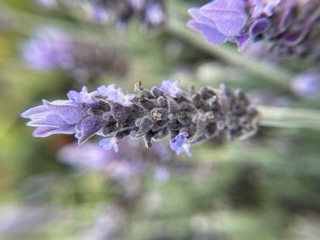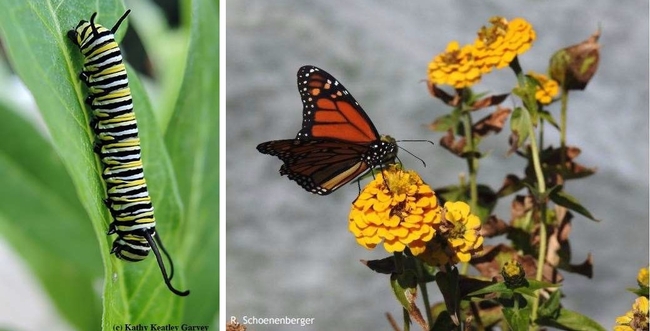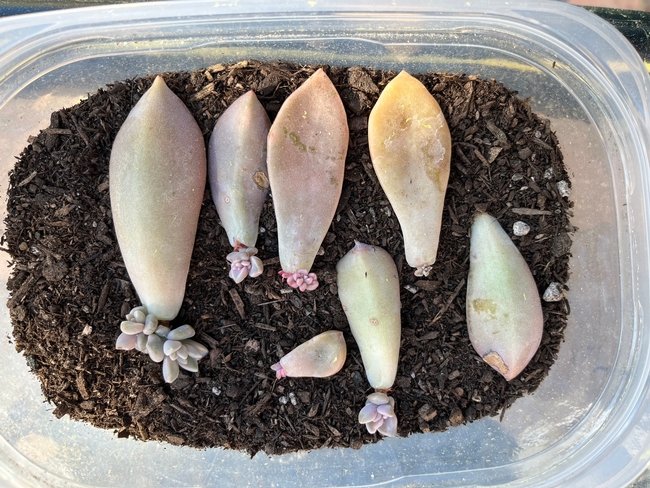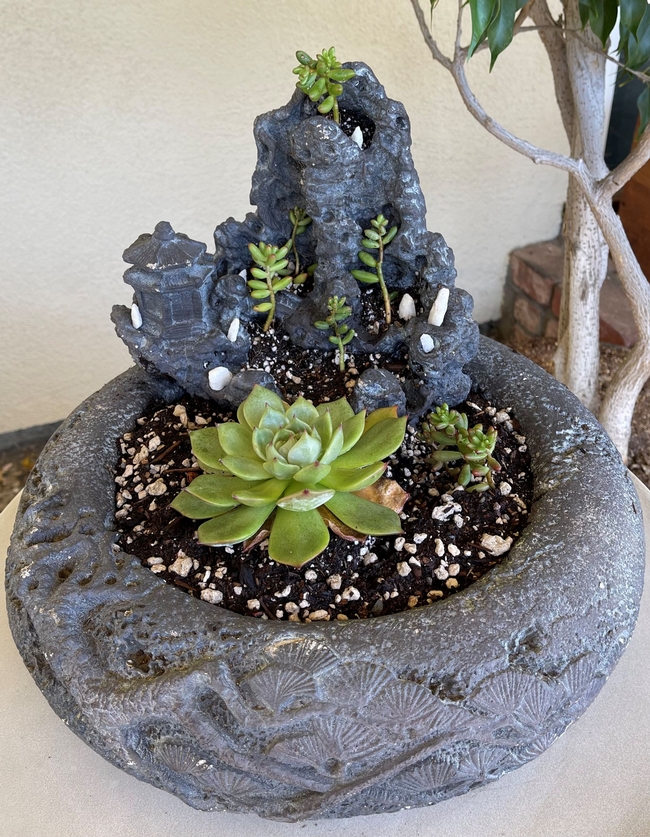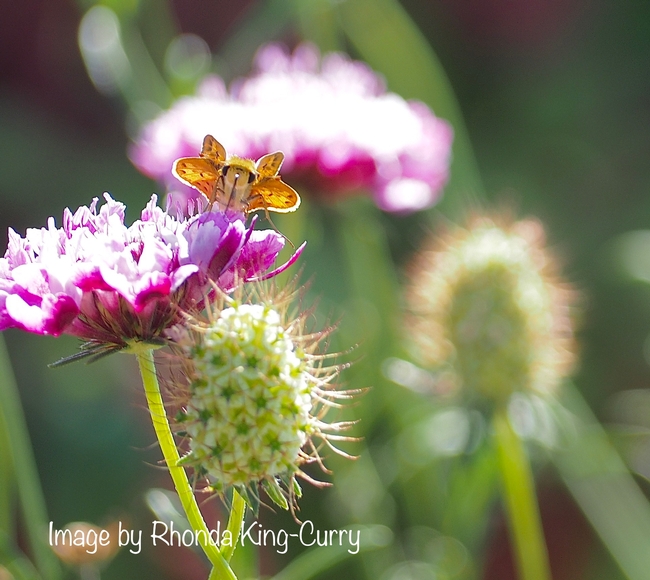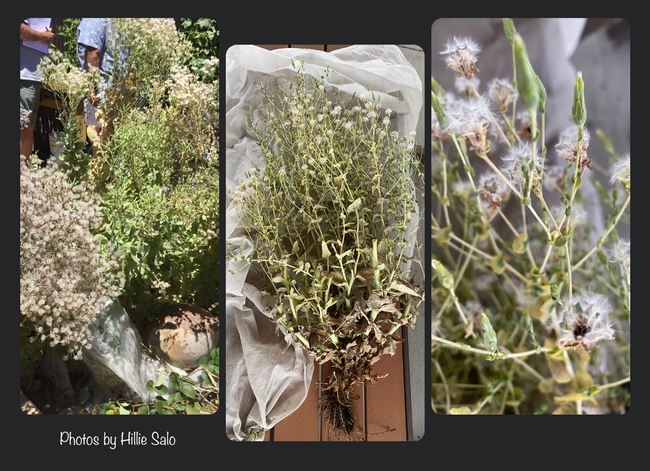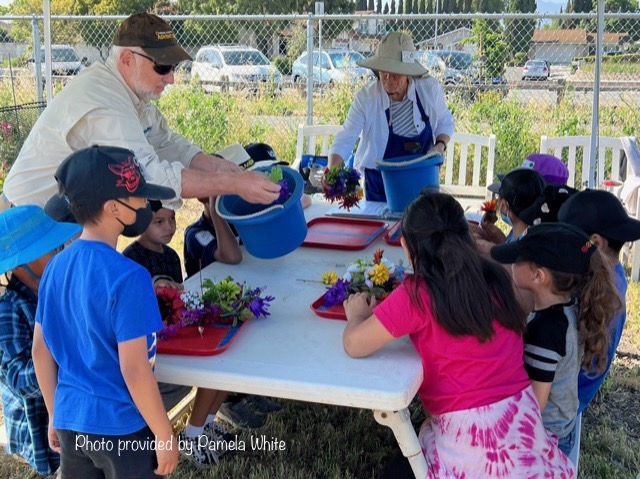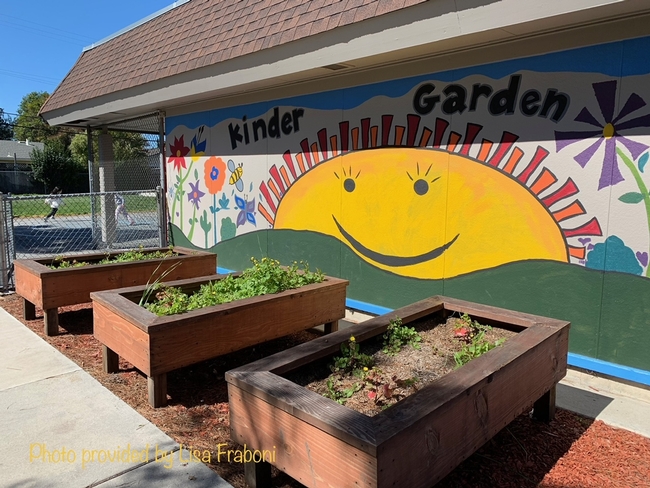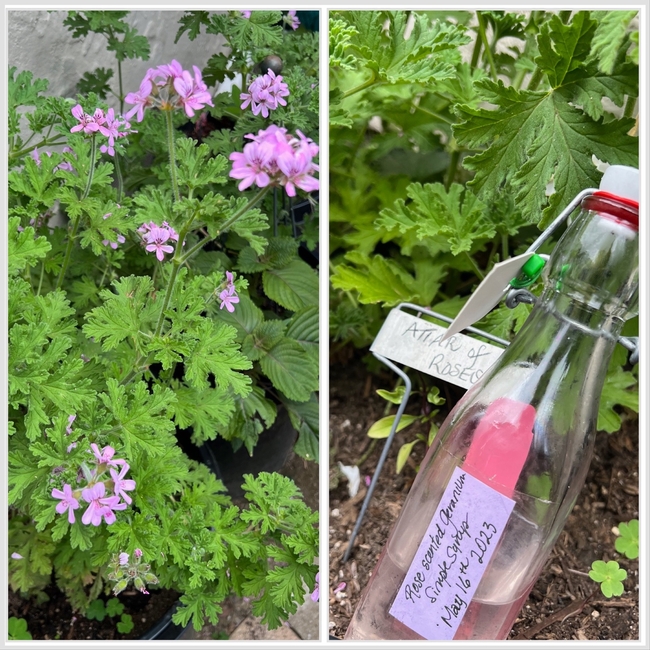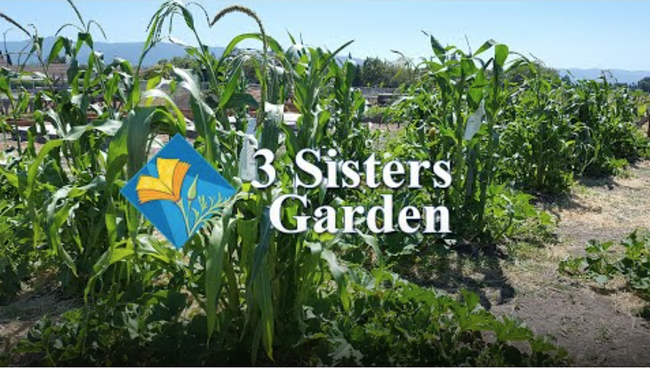Contents:
Home Composting With Worms
by Pamela White
Have you ever seen those full black garbage cans tipped into trucks in your neighborhood? They haul our food waste to the landfill along with other discards we have tossed aside. They smell, they emit greenhouse gasses into the atmosphere, and we pay extra for this service. But is this the best plan for our planet? We know that the answer is “no.”
How can you contribute to replenishing and leaving our planet a better place? Composting is one answer.
You may say you don't have the space, time, or energy to turn those compost piles. You may even say, “They stink!” Have you thought about vermicomposting? In a vermicompost system, worms do the work of recycling organic food waste by consuming your degraded food waste and turning it into valuable worm-casting fertilizer.
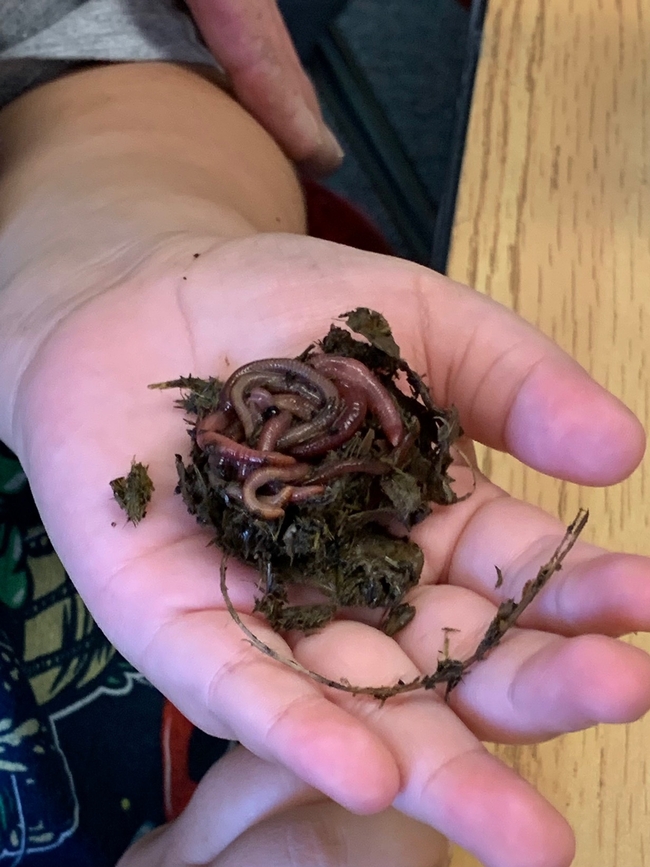
Worm bins don't even smell! What else is on the worms' desirable housing list? They like damp bedding, so get a spray bottle filled with water to moisten the shred. They breathe through their skin which needs to be moist. Oh yes, they don't have any teeth. Instead, they have a gizzard, just like birds. Save your coffee grounds and tea grounds for grit. Even your washed, dried, and pulverized egg shells provide grit for the worms. More ways to recycle from your kitchen to a worm bin.
What happens to all that damp and dry shred, rotting food waste, and grit? After a few weeks, you'll see castings (fancy name for worm poop) and leachate (fancy name for liquid collected from decaying food) in the bin. What do you do with that? Worm castings are considered “black gold”, the best slow release fertilizer you can use for starting seedlings, fertilizing house plants, and top dressing plants in your garden. Then there is the leachate. You can make a 50/50 solution of leachate and water for your plants. Vermicomposting helps the earth and can save you money.
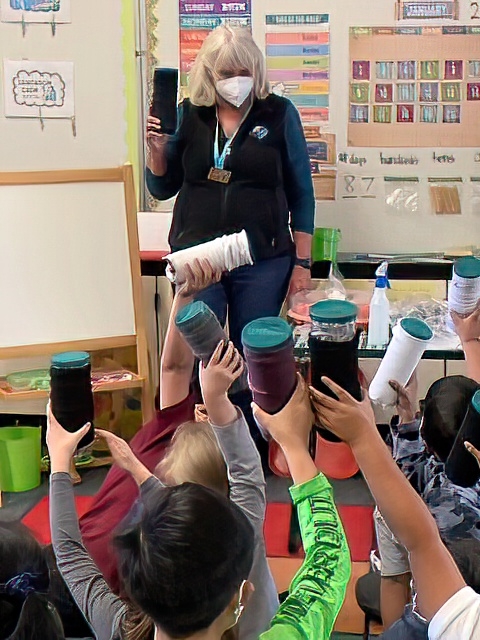
If you're interested, take a look at our Mornings at Martial Cottle Park webpage to learn how to schedule. We have provided workshops for kindergarten through college-aged students. School groups, camps, scouts, college students, and master gardener trainees have participated in our workshops. Our workshops are designed to meet the needs of the community, including those with special needs.
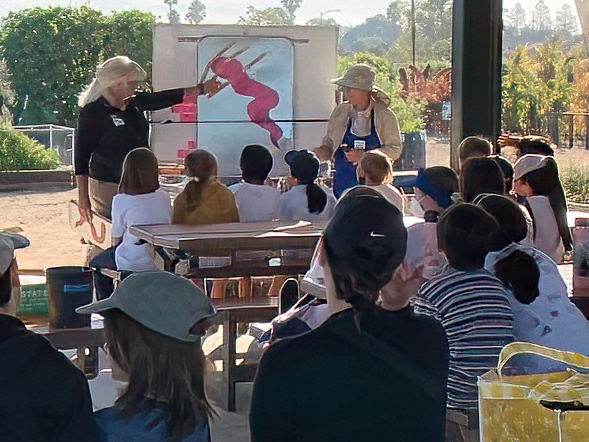
Simply Beautiful Lavender
by Karen Seroff
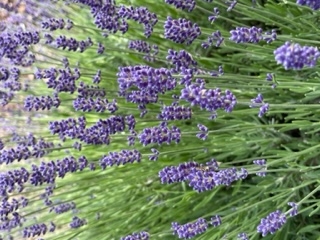
Lavender (Lavendula) is in the mint family (Labiatae) and is traditionally grown as an ornamental plant for culinary purposes and as a producer of essential oils. The name “lavender” is derived from the Latin term “lavare,” which means “to bathe,” and its scent has been associated with cleansing for centuries. Lavenders are woody perennials that prefer full sun and well-drained soil and grow from 1–3' high and 2–4' wide. Advantages of growing lavender include its drought, fire, and deer resistance, low nutrient needs, erosion control, long bloom time, low maintenance, beautiful appearance, and fragrance. Some of the many uses for lavender include use in herbal teas and cooking, fragrances, crafts, sachets, oils and aromatherapy. The scent of lavender is also highly regarded for reducing stress and improving sleep.
Although most people envision the classic English lavender, there are many more species that should be explored. There are three groups of lavender in the genus Lavandula: Spica, Stoechas, and Pterostoechas. Most commercial lavender species are in the Spica group or the Lavandin group (interspecies hybrids). Traditional English lavenders can be listed by any of these names: L. augustifolia, L. latifolia, L. officinalis and L. spica.
Lavandins are cultivated for commercial oil and garden plantings and include Grosso, Standard, Super, and Abrialii for oil, and Grappenhall, Goodwin Creek, Gray, Provence, and Silver Grey for ornamental plants. English lavender cultivars include dwarf, pink-flowered, blue-flowered, and purple-flowered choices. Spanish lavenders (Lavandula stoechas) and their cultivars tend to bloom first in spring. Although not used for oil production, they are wonderful additions to the garden. These showy plants feature small, pineapple-shaped tufts with bracts at the blossom tops that can be purple, blue or white. In addition to being the most drought-tolerant of the lavenders, they often have a second or third bloom period as summer progresses. Some popular Spanish lavenders include L. stoechas ‘Alba', L. pinnata, L. viridis, L. linata boiss, and L. heterophylla. French lavenders are also primarily used as ornamental plants and include the popular species L. dentata.
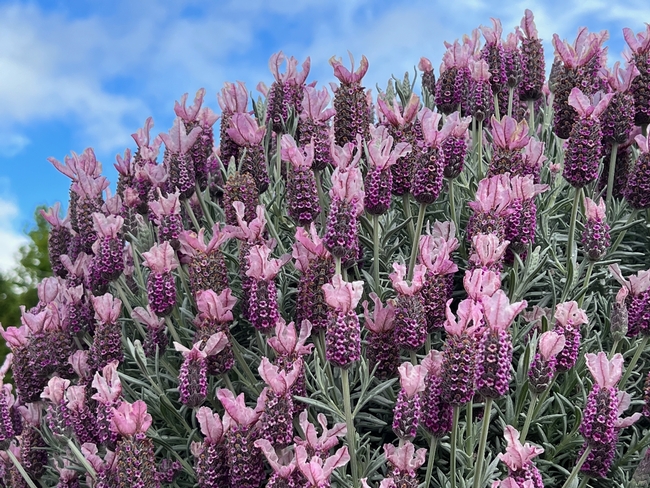
References:
- Lavender, Santa Clara County Master Gardeners
- Lavandula, Sonoma County Master Gardeners
- Lavender for California Gardens, UC ANR Publication 8135 (free download)
Gardening for Awe and Wonder
by Jeff Jenks
Recent books have explored the connections between grief, human biology, brain chemistry, psychology, and emotions and how they are affected by nature, gardening, and horticulture. One such publication from 2023 is “Awe: The New Science of Everyday Wonder and How It Can Transform Your Life” by Dr. Dacher Keltner. In Chapter Six, titled WILD AWE, How Nature Becomes Spiritual, and Heals Bodies and Minds, Dr. Keltner suggests that tending a home garden allows one to witness the remarkable miracles of nature unfolding before their eyes. Planting a tiny seed and observing its growth into a plant with flowers or vegetables is truly awe-inspiring. However, behind this magic lies a realm of fascinating science that often goes unnoticed.
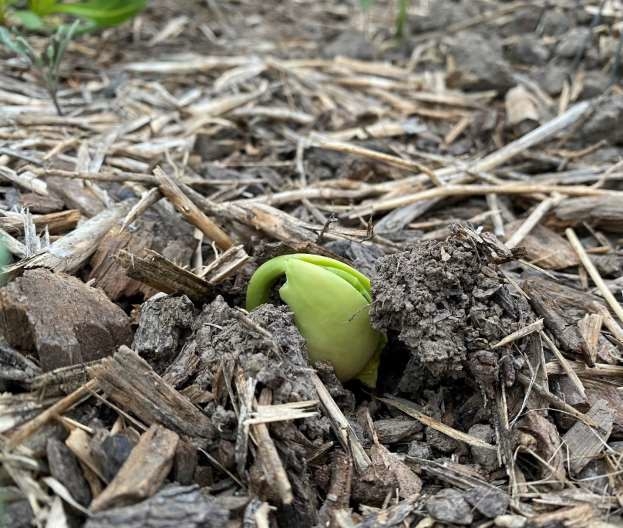
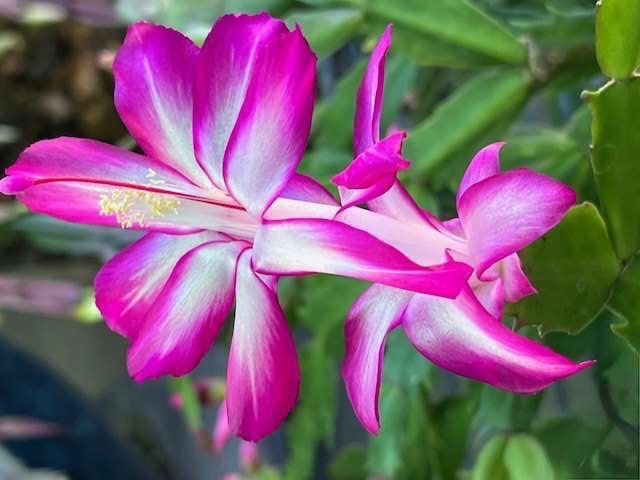
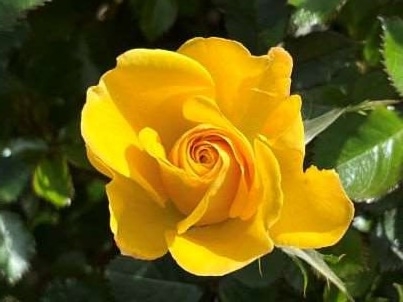
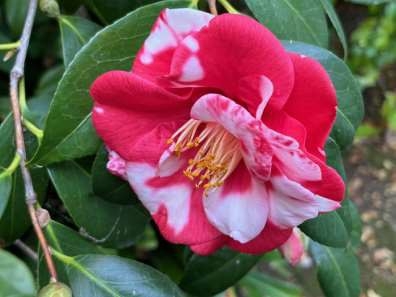
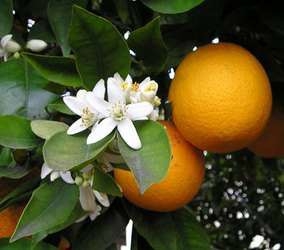
The sight of a brilliant orange-red monarch butterfly on any type of milkweed inspires awe. Milkweed plants are the sole food source for monarch caterpillars. The caterpillars feed exclusively on milkweed, ingesting toxic compounds called cardenolides, which make the caterpillars and adult butterflies unpalatable to predators. Monarch butterflies and milkweed plants have a symbiotic relationship. The monarchs rely on milkweed for food and to acquire their toxicity, while the milkweed benefits from having its seeds dispersed by the butterflies as they lay eggs on the plants.
Master Gardeners create and give presentations like All About Monarch Butterflies and How to Garden for Monarch Habitat. Monarch butterflies are beneficial pollinator insects. Other insects like termites are NOT. UC Master Gardeners offer a Plant Clinic Online where you can provide a photo of the damaged leaves, and a Master Gardener can help diagnose whether it's insect damage or a plant disease. We also provide education and training in Integrated Pest Management as another way of supporting the mission of the UC Master Gardeners.
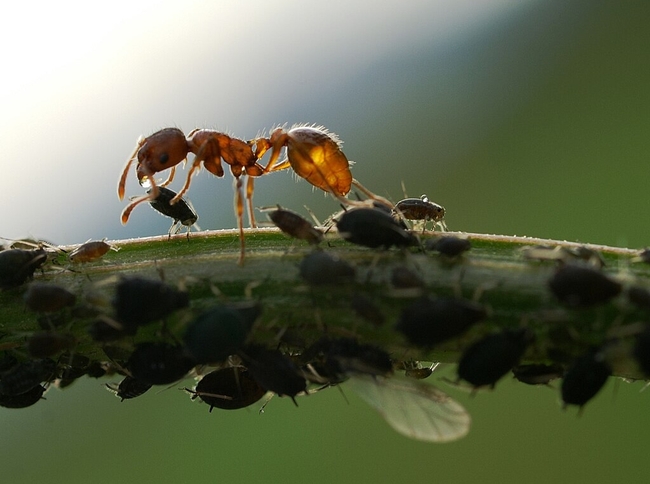
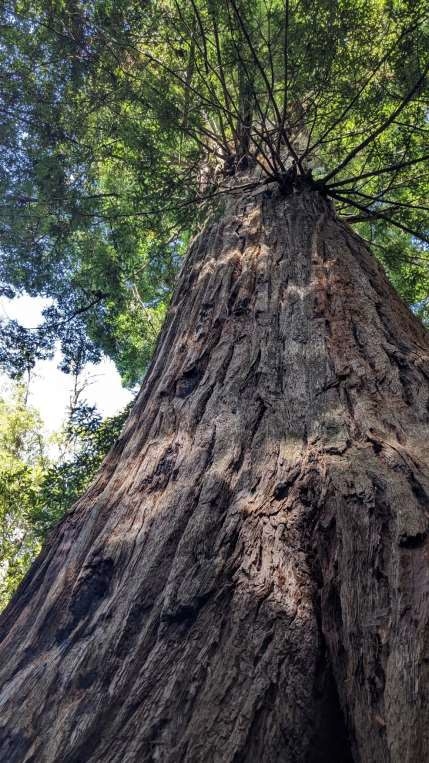
Sadly, invasive shothole borers have arrived in Santa Clara County after causing the death of thousands of trees in Southern California. The Master Gardeners of Santa Clara County are getting educated on what we can do about this horrific tree pest.
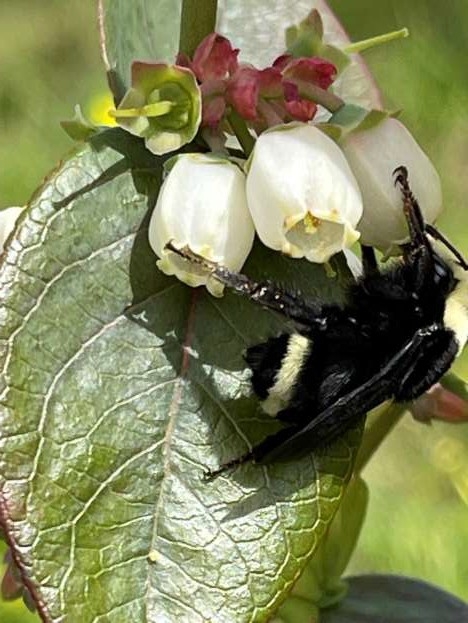
For more information about growing blueberries in Santa Clara County, refer to the handout Growing Blueberries in Santa Clara County. Or watch Blueberries in Abundance on our YouTube channel.
The image on the right is Bombus terrestris bumblebee pollinating a Southern Highbush type of blueberry plant.
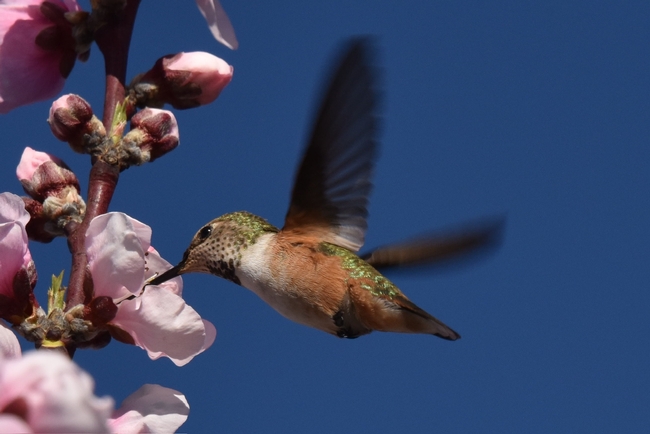
The Master Gardeners of Santa Clara County publish a blog titled Thyme to Garden, which explores various gardening topics that highlight the awe-inspiring aspects of nature. You are reading this Blog as you read this post. Experiencing AWE takes some effort. You need to consciously seek it while you are gardening, taking a walk, or planting new flowers in the spring. The effort may restore your life. So go out and do some gardening.
The Master Gardeners of Santa Clara County offer Advice to Grow By… Ask Us!
References:
- AWE: The New Science of Everyday Wonder and How It Can Transform Your Life, by Dacher Keltner, 2023
- The Well-Gardened Mind, The Restorative Power of Nature, by Sue Stuart-Smith, 2020
- The Many Mental Health Benefits of Gardening, PennState Extension Master Gardeners, January 22, 2024
- Gardening can relieve human stress and boost nature connection during the COVID-19 pandemic, by Monika Egerer, Brenda Lin, Jonathan Kingsley, Pauline Marsh, Lucy Diekmann, and Alessandro Ossolag, Urban Forestry & Urban Greening, Volume 68, February 2022
Contents:
- Home Gardeners Are Important Keepers Of Biodiversity
- Growing Succulents is Easy and Fun
- Fruit Tree Pruning
- Add a Splash of Citrus to Your Yard
Home Gardeners Are Important Keepers Of Biodiversity
by Hillie Salo
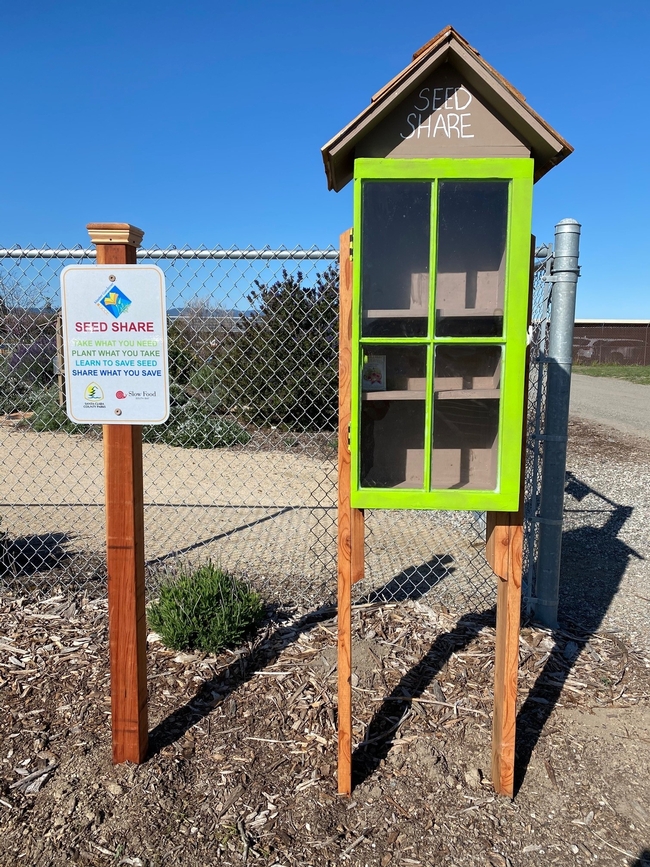
What's important about diversity? Similar to your financial assets, where it is recommended to have a diverse portfolio, a diverse gene pool affords greater protection in times of crisis; if one individual fails, diversity will allow for the survival of others and the species.
Saving and sharing seeds is an important step towards building, strengthening, and preserving this biogenetic diversity. Individually, we each have a very small gene pool, probably not much larger than the palm of your hand or a small seed packet. But together, a community can create a much larger gene pool preserving greater diversity.
Seed saving and sharing is so important that it has warranted a note by the CA legislature: “Noncommercial seed sharing activity contributes significant value to the health of our communities and the resilience of our food system.”
Seed sharing opportunities can be found at your local Seed Library. The basic idea behind Seed Libraries is seeds are “checked out” and planted in the garden. Successful plants are let go to seed. The seed is collected, and then a portion is returned to the Seed Library, ready to be planted by future gardeners, thus creating a circle of seed saving and seed sharing in your local community. This process builds genetic diversity and gives access to locally grown seeds. Those seeds may be adapted to local conditions increasing their ability to survive and produce. Common bean seeds have been shown to exhibit signs of adaptation within three years.
Local Seed Libraries can be found at many city public libraries, including San Jose Public Libraries at the Almaden, Berryessa, Calabazas, Tully, and Willow Glen branches, as well as the Santa Clara City Library, Mountain View Public Library, and Santa Clara County Library, Gilroy branch. If your search for a seed library does not reveal one at your local library, you might like to suggest that one be added to their services. Every community can benefit from a Seed Library, even and especially school libraries.
More info:
- Home Gardens: Neglected Hotspots of Agro-Biodiversity and Cultural Diversity, ResearchGate
- Homegardens in a micro-regional scale: contributions to agrobiodiversity conservation in an urban-rural context, Ethnobiology and Conservation
- Biodiversity in residential gardens: a review of the evidence base, Biodiversity and Conservation
- Food Gardens for a Changing World, UC Food Observer
- Seeds of change? Social practices of urban community seed sharing initiatives for just transitions to sustainability, The International Journal of Justice and Sustainability, Volume 27, 2022 - Issue 6
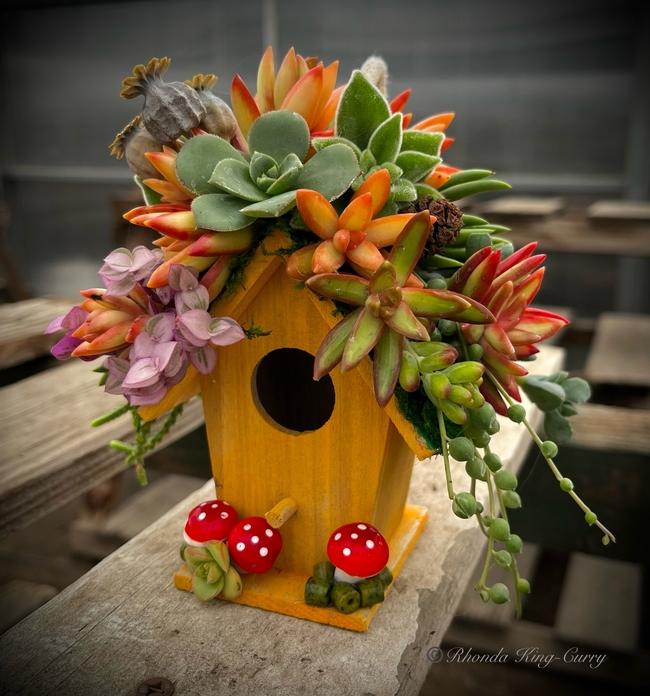 Growing Succulents is Easy and Fun
Growing Succulents is Easy and Fun

by Angie Chiappa
Succulents are plants with thick fleshy stems and leaves that collect and store water. They come in all shapes and sizes, many quite dramatic with beautiful flowers. They are also very easy to grow and are adaptable to many environmental conditions. Although sun loving, often just very good light is enough for them to grow. You can grow them in the ground or in pots, inside or outside. If they have air circulation and good drainage, they can be grown among other types of drought tolerant plants. If you are a new gardener or struggle to grow plants, succulents are for you! All cactus plants are succulents, but not all succulents are cacti. Many succulents do not have thorns and instead have rosettes, fleshy leaves, tall and thin, short with small leaves, and all sizes and shapes in between.
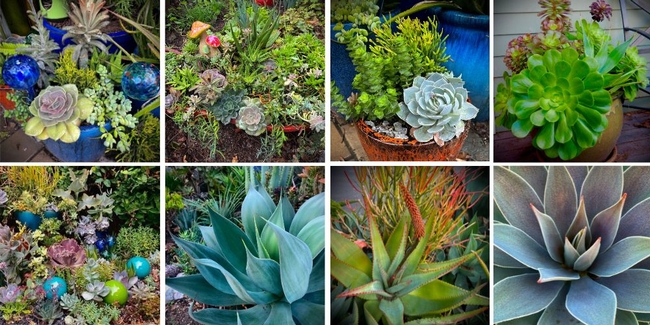
Photos: assorted succulents, by Rhonda King-Curry
Like all plants, succulents have a particular growing season. Propagate or replant winter-growing succulents in the fall and summer-growing succulents in the spring. The growing season is not necessarily the time of flowering. The flowers can appear before, during, or after the growing season.
About soil: The Master Gardeners succulent group at Martial Cottle Park in San Jose uses regular potting soil and mix in pumice.
About propagation: Propagate using a small plant piece and stick it directly in the soil after the cut dries. If there are no roots, do not water much. When the roots show, then you can water. Another way to propagate very fleshy leaves is to lay them on a slightly damp bed of soil. See the photo below.
Caring for succulents has one big rule: DON'T OVER WATER.
Water deeply once, then let it dry out. Throwing a little water on top every day will not make the plant thrive. When in doubt, DON'T water. Too much water rots the crown and stems, thereby killing the plant.
If the succulent shrivels from lack of water, it can be revived just by watering it.
The amount of sun, size and type of containers, location (outdoors or indoors) and temperatures (close to freezing or very hot), determine when to water and whether the plant will thrive.
Succulents close to dying can be revived with some care and experimentation. If you receive a half-dead succulent snippet or an item decorated with succulents, cut off the dead parts and try growing the healthy snippet. You may be surprised and end up with a nice plant!
Looking for some succulents? The Master Gardeners succulent group sells succulents on the third Saturday of every month, from 9 am–noon at Martial Cottle Park. There are hundreds of plants to choose from. We hope to see you there.
The succulents webpage on our website has more info.
Below is a repurposed tabletop water fountain decorated with succulents. A good idea during a drought when every drop of water is precious. Also, it's a great time to grow succulents during a drought.
More info:
- Succulents and Cacti, El Dorado Master Gardeners
- Growing Succulents, Santa Clara Master Gardeners
- Propagation of Cacti & Succulents, Ernesto Sandoval talk at the 2017 Convention of the Cactus and Succulent Society of America, YouTube
- Cacti and succulents identification, plantsam.com
Fruit Tree Pruning
by Amanda Crooks
The time to prune dormant fruit trees is here. With the exception of apricot and cherry trees, winter is the best time to prune most deciduous fruit trees. Apricot and cherry trees should be pruned in the summer, when there is a higher chance of no rain for 6 weeks after pruning, to reduce the risk of Eutypa dieback.
Here are some general pruning tips.
- Gather your tools
- Hand pruning shears
- Lopping shears with 24–30" handles
- A folding or fixed handled pruning saw, with 8–15" curved blades and wide set teeth
- Make sure the blades are sharp to cut as cleanly as possible. Dull blades can leave rough cuts and increase the potential for disease or pests to affect the tree.
- When deciding which branch to cut and where to cut it, keep in mind:
- Topping a vertical branch encourages vegetative growth and opens the tree to more sunlight.
- Topping a horizontal branch renews fruiting wood and thins out excessive fruit. Horizontal branches left uncut will bear earlier and heavier crops.
- Do most of the pruning in the top of the tree so that the lower branches are exposed to sunlight. Branches exposed to sun will remain fruitful and produce the largest fruit. Shaded branches will eventually stop fruiting.
- Remove suckers, water sprouts, and most competing branches that grow straight up into the tree. Also remove any downward-bending branches.
- Tree-specific guidelines on how much to prune:
- For peach and nectarine trees, remove about 50% of last year's growth.
- For fig, apple, pear, plum, and apricot trees, remove about 20% of last year's growth.
- For cherry trees, only prune in the first 5 years of the tree's life, focusing on creating a proper structure with an open center and adequate spacing between scaffold branches.
- Try to prune when there is little to no rain in the forecast. Rain shortly after pruning can increase the risk of disease and pests affecting the tree.
- If you have a “fruit salad” tree with multiple varieties grafted onto a single tree, prune only the tips of branches in the summer to avoid removing all grafted material.
- Research does not support the use of wound sealing or tree sealant materials on pruning cuts; leave them exposed to the air after pruning.
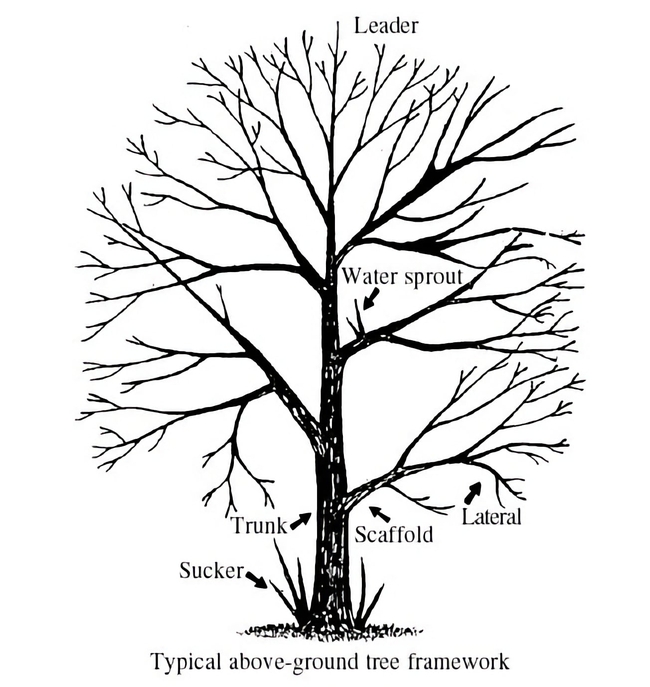
Illustration: Virginia Cooperative Extension
If you have any overgrown or neglected fruit trees in your yard, it is possible to revive them through pruning. However, it's important to note that if fruit production is your goal, it may be best to replace the tree with a new one. Some things to keep in mind when trying to prune an overgrown fruit tree:
- It can take two to three years to prune a neglected fruit tree adequately enough to encourage fruit production.
- Focus on rejuvenating the tree into one that is structurally sound, functional, manageable, and attractive.
- A few large pruning cuts accomplish more than many small cuts. Avoid over-pruning.
- Stand back frequently and look at the tree several times to visualize where to prune and the future structure you desire.
More info:
- Eutypa dieback, UC Integrated Pest Management
- Pruning and Training, UC ANR Publication 8058
- Reviving Neglected Fruit Trees, UC ANR Publication 8058
Add a Splash of Citrus to Your Yard
By Karen Seroff
Let's talk about citrus! Besides being a wonderful source of vitamin C, citrus fruits are often used for garnishes, for adding a bright flavor to culinary dishes, and even displayed in a bowl to add color to a kitchen. Their fragrant blossoms are attractive to people and pollinators alike. Citrus are evergreen plants that can live and produce fruit for many years. They can be grown as a bush or shaped into a tree form as they grow taller, or even espaliered, adding beauty and interest to your landscape.
But what citrus plants grow best in Santa Clara County? Do they need special care to be productive? Let's explore a few of the varieties of citrus that are recommended for our area and how to best care for them.
Some recommended citrus varieties for Santa Clara County:
- Oranges: Lane's Late Navel, Valencia, Washington Navel, Robertson's Navel, Trovita, Cara Cara
- Blood Orange: Moro
- Sour Oranges: Chinotto, Seville, Bergamot, Bouquet de Fleurs
- Mandarins: Clementine, Dancy, Fremont, Kara, Kinnow, Page, Satsuma, Encore, Nova, Shasta Gold
- Grapefruit: Oro Blanco (grapefruit/pomelo hybrid)
- Lemons: Eureka, Lisbon, Meyer, Pink, Improved Meyer (free of tristeza virus)
- Limes: Bearss
- Kumquats: Meiwa, Nagami
- Tangelos: Minneola
- Unusual Citrus Varieties:
- Buddhas Hand Citron
- Makrut Lime (Thai or Indonesian Lime)
- Kumquat hybrids-Limequat, orangequat, and calamondin
Many other varieties may also do well in Santa Clara County. The above list is based on UC Master Gardener trials, taste tests, and feedback from local growers.
Where to Plant: Citrus will do best if planted in a sunny, warm location. Southwestern exposure or a location near a patio or driveway will maximize natural and reflected warmth. Avoid planting citrus in a lawn or near areas where they will receive excessive water.
When to Plant: Although citrus can be planted at any time of the year, the best time is after the last frost in spring (mid-March to April).
Planting Instructions: Dig the planting hole slightly less deep than the root ball and twice as wide. Avoid adding amendments, as the tree will grow best in native soil. Plant with the root ball about one inch above the surrounding soil for good drainage. Create a watering basin around the plant, sloping down away from the trunk. Trunk sunburn can be prevented by painting the trunk with white interior latex paint diluted 1:1 with water. Add a 3–4 inch layer of mulch around the tree to conserve moisture and reduce weeds. Make sure mulch is at least 6 inches away from the trunk. Citrus can also be planted in containers. Look for naturally smaller trees. Use at least a 15-gallon container. Water when the top 2–3 inches of soil is dry, and fertilize once or twice a month. Be prepared to transplant to a larger container when it becomes necessary.
Harvesting Citrus Fruit: The first 3–4 years after planting a citrus tree are considered “nonbearing” years. There may be some light fruit production, but most of the plant's energy is used in developing root and branch growth. Trees will often drop some fruit and may be alternate bearing (heavy crop one year, light crop the next). It is important to let the fruit develop on the tree, as it won't continue to ripen once picked. Tasting fruit periodically will help indicate when it is best to pick. Color is not always a good indicator of ripeness.
Freeze Concerns: Citrus trees are subtropical to tropical in nature. Therefore, freezing temperatures can cause severe damage and possibly even death of the plant. You can help protect your citrus by watering several days before an expected freeze and draping the tops of citrus trees with blankets or plastic. Remove the covering once the weather warms up to prevent the trees from overheating.
More Information:
- Growing Great Citrus, Santa Clara County Master Gardeners
- Citrus Cultural Tips, Pests and Disorders, UC Integrated Pest Management
- Citrus, The California Backyard Orchard, UC ANR
- Frost Protection for Citrus and Other Subtropicals, UC ANR Publication 8100
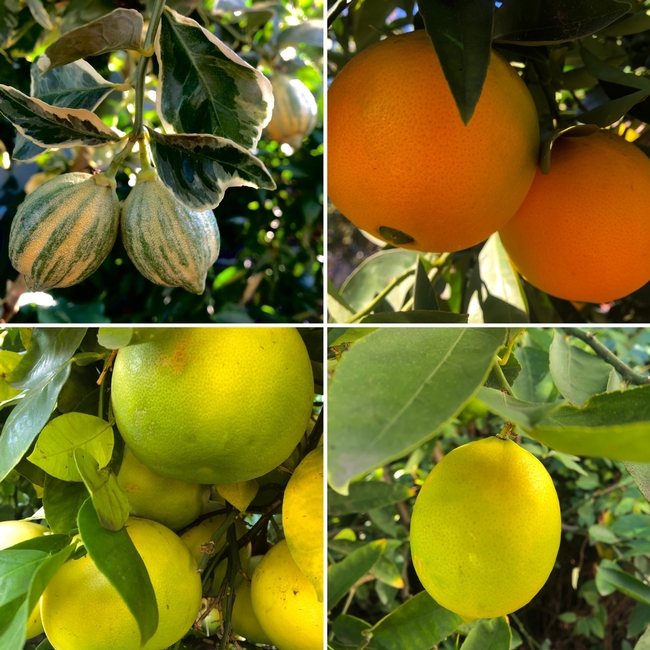
Photo (clockwise from top left): 'Pink Lemonade' lemon, Washington Navel Orange, Bearss Lime, and 'Oro Blanco' Grapefruit, by Rhonda King-Curry
- Author: Rhonda King-Curry
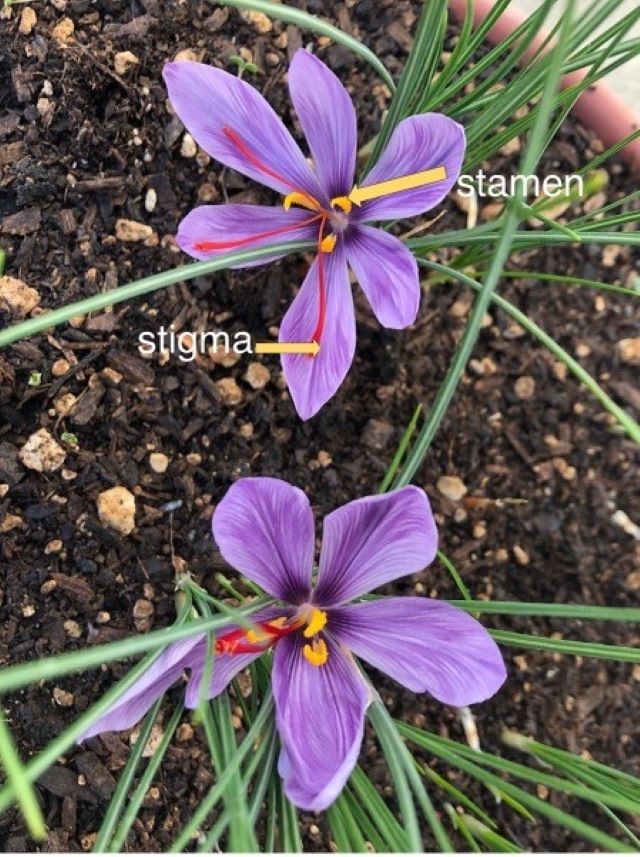
- Saffron, UC Master Gardeners, Santa Clara County
- Crocus sativus, Missouri Botanical Garden
- UCCE Central Coast & South Region, Center for Landscape and Urban Horticulture
- Grow Your Own Saffron, Washington State University
- Colchicum, North Carolina Cooperative Extension
Photo via UCCE Santa Clara County Master Gardeners
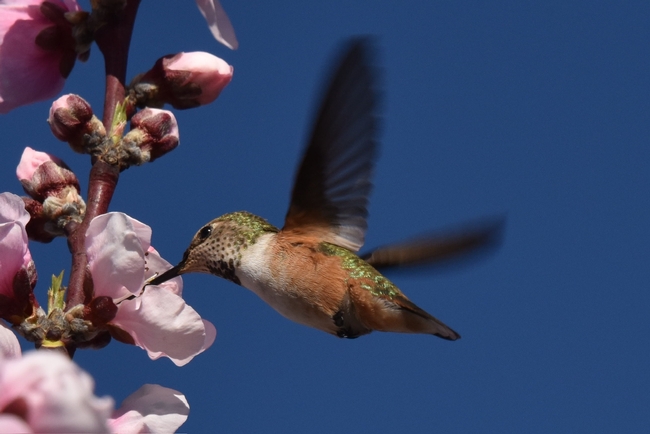
- Allen's Hummingbird (Selasphorus sasin) - breeds in coastal areas from Southern California to Oregon, a close relative of the Rufous Hummingbird and similar in appearance.
- Anna's Hummingbird (Calypte anna) - the largest hummingbird in California, a year-round resident, able to sing.
- Black-chinned Hummingbird (Archilochus alexandri) - breed in the U.S. during summer and travel to Western Mexico for winter. Prefer habitats close to water.
- Calliope Hummingbird (Selasphorus calliope) - smallest breeding bird in North America - the weight of a penny! Spends summers in mountain habitats from Southern California to Oregon.
- Costa's Hummingbird (Calypte costae) - can be found in California's deserts and along the coast. Has a distinctive voice.
- Rufous Hummingbird (Selasphorus rufus) - travels from summer in Alaska to winter in Mexico - one of longest known migratory flights. Populations are in decline.
- Franciscan manzanita (A. franciscana) — a 1' tall mounding groundcover with pink and white flowers
- Chaparral currant (Ribes malvaceum) — a small fragrant shrub with pale pink hanging flowers.
- Fuchsia-flowered gooseberry (Ribes speciosum) — a large, easy-to-shrub with abundant hanging red flowers.
- Sierra Azul Preserve History
- USDA: Maintaining and Improving Habitat for Hummingbirds in California
- https://westernhummingbird.org/habitat/
- https://www.cnps.org/gardening/hummingbird-gardening-5098
- What You May Not Know About Hummingbirds
Step 2: Gather materials
- Tacky glue
- Dry moss
- Hot glue gun
- Garden clippers
- Wooden chopstick (to keep your fingers away from the hot glue)
- Succulent cuttings (consider different textures, colors, heights, sizes and shapes). Be wary of succulents with farnia on them (it's a natural coating that acts like sunscreen for the succulent). Touching the farnia will cause it to rub off and it won't look so great to have fingerprints on your succulents.
- Dried material (examples include small pine cones, dried seed pods, poppy pods, dried grasses such as wheat or barley, acorns, magnolia seed pods, black walnut seed halves, clusters of dried berries, dried Jacaranda pods -- anything that won't come apart as it dries further.
Step 3: Apply the tacky glue to the top of the pumpkin, spreading it out about 2/3 of the way to the edges.
Step 4: Add the moss and press down gently to adhere. You don't need to wait very long for it to dry. I usually just get right to the next steps and let it dry as I'm working.
Step 5: Select Thrillers, Fillers & Spillers. Thrillers will be larger, spectacular succulents, using 1 - 3 depending on the pumpkin size. Spillers are materials that will dangle over the edge and spill down. Fillers are not as spectacular as thrillers but will add some color or texture to the arrangement.
Apply hot glue to the succulent stem (and/or pumpkin stem) then apply pressure using the chopstick until it stays where you want it. Repeat with more succulents and dried material, turning the pumpkin as you go to keep your arrangement filled out on all sides.
Be sure to remove the lower leaves from succulents so that you have at least an inch of stem to apply hot glue. You save the leftover leaves or stems. They will eventually continue to grow. Place them on top of soil and keep them moist by spritzing them with water to keep them from drying out. Leaves will shrivel up and give energy to make a new tiny succulent.Tips: If you see a big gap that you don't know what to do with, select a succulent with a rosette shape to fill the gap easily with its wide flower shape.
Start with longer stems, but snip to shorten them as needed.
Your succulent-topped pumpkin will last for months (longer if you give enough indirect light so that the rosette shapes don't elongate to reach for the sun). Spritz with water each week to keep the moss a bit moist and for root development. After the holiday season succulents can be replanted or you can cut off the top of the pumpkin and plant that.
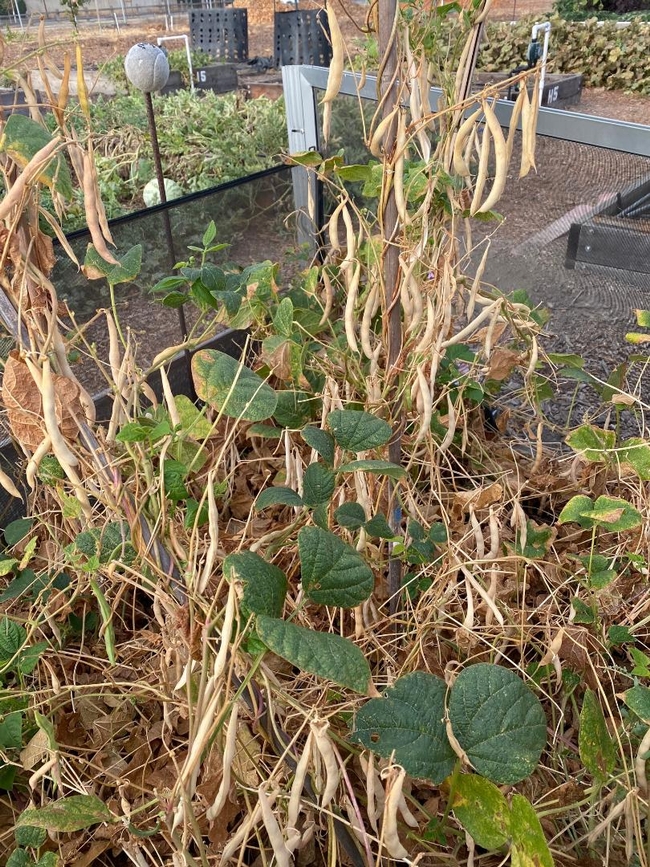
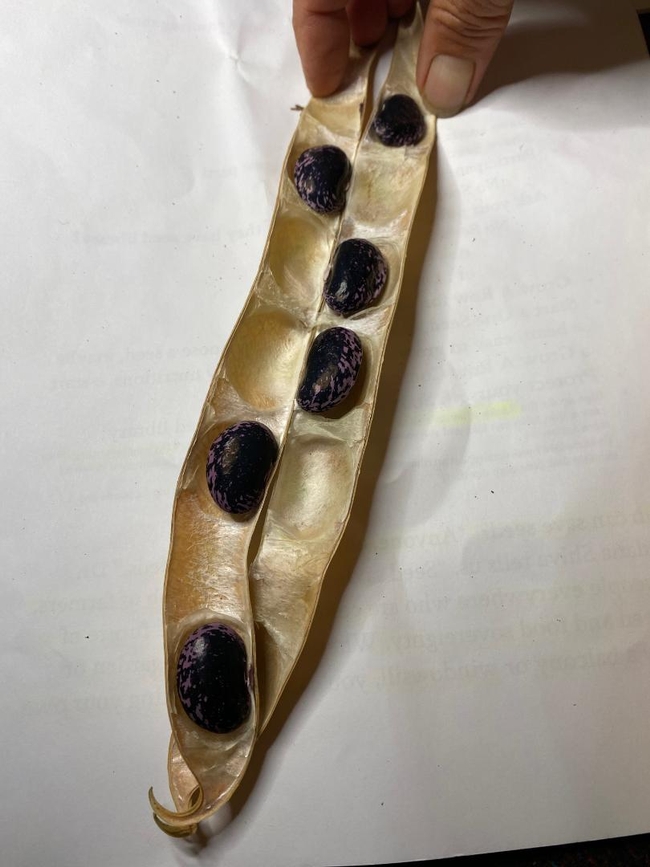
The Tale Of Two Dwarf Alberta Spruce Christmas Trees in Santa Clara County
by Jeffrey Jenks
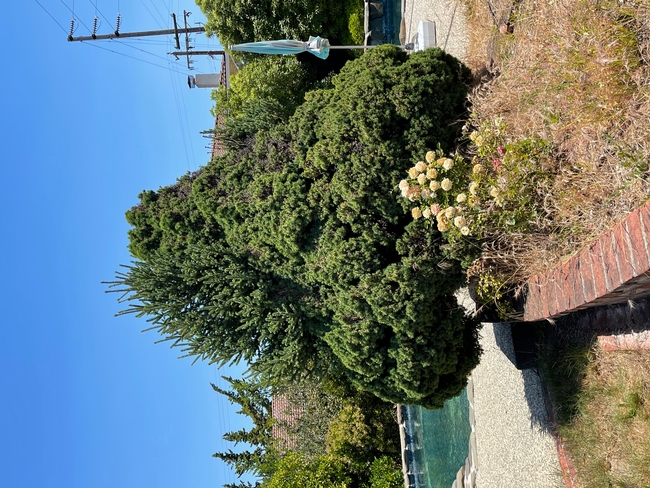
Planted over 30 years ago, this mature dwarf Alberta spruce (Picea glauca var. albertiana ‘Conica') in Cupertino has reverted and is now growing like a normal white spruce. This phenomenon is called “genetic reversion.”
How did this happen? Originally, buds or cuttings from an Alberta spruce plant were grafted onto a spruce rootstock and remained true to form. This is how many cultivars, such as Alberta spruce, originate. However, just as the original genetic mutation occurred to produce the cultivar, occasionally a reverse mutation occurs and portions of the plant “revert” back to the species' normal growth.
A blog post from the UC Master Gardener Program of Napa County describes this same reversion with a confirming photo.
What should have been done when the reversion occurred? Examine the tree to determine where the reversion originated and prune the branch back to that point. Often, reverted shoots grow more vigorously than the rest of the tree. Unfortunately, this dwarf Alberta spruce was left with multiple un-pruned, reversions that now dominate the tree.
This has created a difficult decision that may result in removing the tree completely since it has outgrown its place in the landscape, pruning out the normal white spruce branches leaving “holes” in the conical shape, or pruning the outgrowths to be flush retaining the conical shape. It's best to “nip it in the bud” when a reversion first appears.
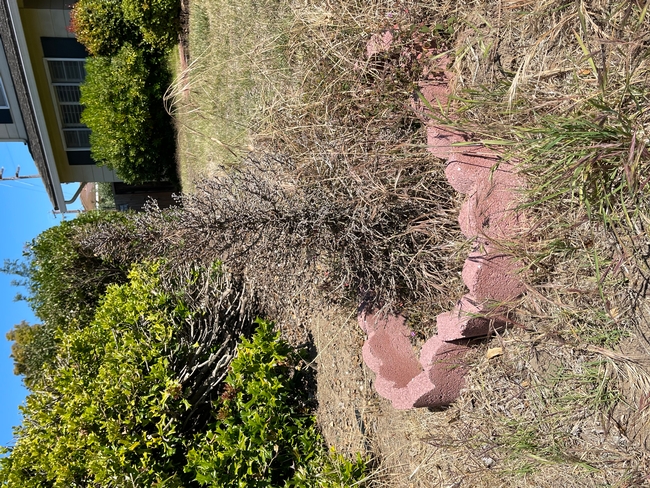
Transplanted from a nursery in about 2020, this dwarf Alberta spruce Christmas tree in the same yard in Cupertino is dead. How did this happen when the same species of tree grew to maturity in the backyard as shown above? One explanation is that dwarf Alberta Spruce is only hardy in USDA zones 3–8. Cupertino is in USDA zone 9b.
What can be learned from these stories about two dwarf Alberta spruce Christmas trees?
- If you want to take the dwarf Alberta spruce Christmas tree that you bought at the nursery and transplant it in your landscape and have it be hardy, check to be sure you are in USDA zones 3–8.
- If you do plant a dwarf Alberta spruce Christmas tree and you want it to retain its conical shape and avoid reversion, then at the first sign of a branch emerging that is below the graft union prune the branch back to the point of the reversion.
- Finally from the Holiday Ideas section of the UC Master Gardeners of Santa Clara County, consider renting a tree from Our City Forest as it's on its way to a permanent home in the community.
Fall is here, which means it's time to start harvesting fall tree fruits. If you have any apple, pear, pomegranate, persimmon, or nut trees in your yard, you may be closely monitoring the fruit to harvest it at the right time. Read below for some fall fruit harvesting tips.
Some general fruit harvesting and storage tips include:
- Use your senses to determine when the fruit is ripe enough to pick. Look at the color, feel it, and pay attention to the size.
- Harvest when the fruit is cool (ideally in the early morning) and keep the harvested fruit cool to promote fruit quality and shelf life.
- Twist and lift the fruit up to remove it from the tree; don't pull straight down on it.
- Handle harvested fruit carefully to avoid bruising or puncturing the skin.
- If needed, let the fruit ripen in a cool, dry place inside. Then store in a refrigerator or other cool storage to maintain freshness.
- Fruit on the same tree may ripen at different rates, so you may need to harvest at different times.
Apples
Apples can either be left to ripen on the tree, or you can pick them before maturity and let them ripen after harvest. But don't leave them too long, as apples left on the tree tend to drop off the tree and can also become mealy. After harvesting your apple crop, fertilize the tree and remove any fallen fruit to control for codling moths. After leaves fall, remove and discard or compost them to prevent the spread of apple scab.
Two pears ready to pick, and one left too long on the tree (photo credit: Amanda Crooks)
Pears
Unlike apples, pears must be picked before they're ripe. Do not let them ripen on the tree. Follow similar horticultural practices with pears as you would an apple tree post-harvest. Note: this is different for Asian pears. The Clemson Extension says:
Two persimmons starting to change color. (photo credit: Amanda Crooks)
Persimmons
Persimmons should also be harvested before they fully ripen. Harvest after the skin has turned orange, but before they begin to soften. Make sure to use some shears or snippers to cut the persimmon off the tree; don't twist and pull them off like pears and apples.
Pomegranates
Look for shiny, red, leathery skin and large firm fruit before harvesting pomegranates. Like persimmons, pomegranates should also be clipped off the tree using shears rather than pulled off. Wear thick gloves and protective clothing to avoid getting poked by thorns. Pomegranates are highly susceptible to damage, so handle them carefully.
Nuts
Depending on the nut tree you have, look for changes in size, color, or cracks or changes in the hulls before harvesting. Most nuts will drop easily off the tree when they're ready to harvest. You'll want to cure some nuts, such as hazelnuts or walnuts, before consuming.
Sources:
- The California Backyard Orchard UCANR
- Harvesting Fruit: UC Master Gardeners of Alameda County
- UC Davis Fruit and Nut Resource & Information Center
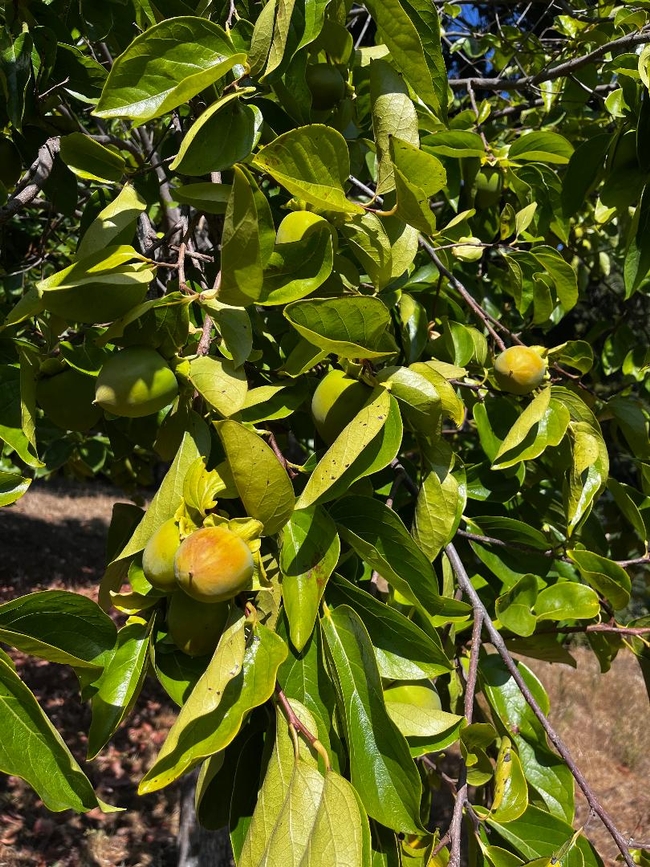
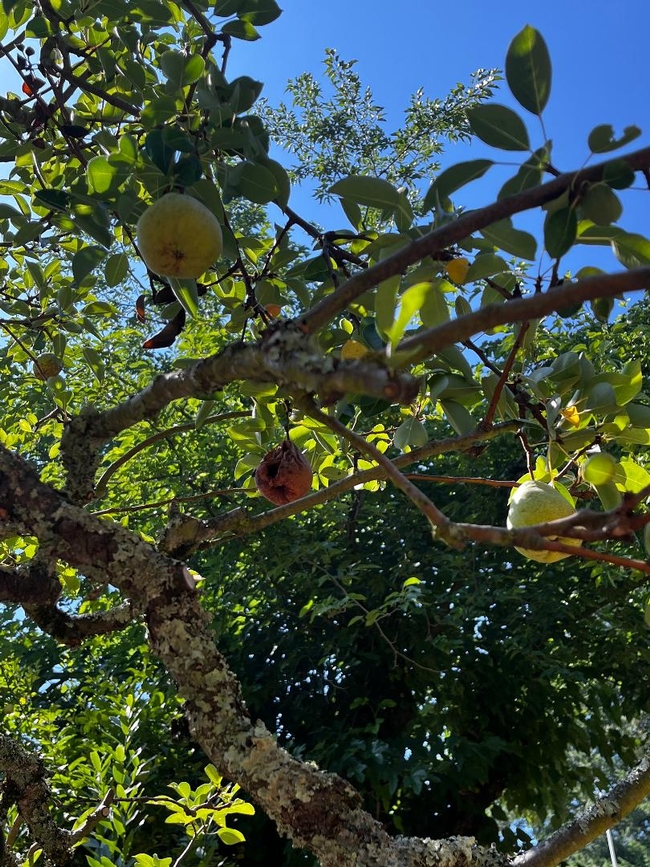
Welcome to Thyme to Garden, the new blog from the UC Master Gardener Program of Santa Clara County.
We look forward to offering you content that is thought-provoking, informative, and helpful in your gardening adventures. We hope we can provide you with some of those “I learned something new” moments and that you'll look forward to each seasonal issue of Thyme to Garden! Subscribe to receive our quarterly blog in your inbox!
Pollinators Need Our Help
By Rhonda King-Curry
You've probably read that pollinator populations are declining worldwide. Pollinators are important. They are responsible for 1 of every 3 bites of food we eat. Mounting evidence shows that home gardens can make a big difference in helping pollinators. How can you help? In addition to skipping the pesticides, pollinators need three things: food, shelter, and water.
Food: Grow flowers of different sizes, heights, shapes, and colors that are planted in clusters (3'x'3 drifts) that offer different blooms almost year-round. Growing different kinds of flowers will ensure there's something for everyone. Pollinators will be busy from late winter through the end of autumn foraging at flowers, so having a variety of flower types will ensure different pollinators have something just right for them.
Tiny native bees need tiny flowers—let some of your herbs make their tiny flowers. Umbel-shaped (umbrella-like) and flat flowers allow landing pads for butterflies and medium-sized bees. Tubular-shaped flowers are good for hovering pollinators like hummingbirds or larger bees that grasp onto the petals of flowers to hang on. Don't worry about focusing on planting only red tubular flowers for hummingbirds. They'll forage at all flower colors. With red flowers, they have less competition from bees because bees only see ultraviolet light. Bees can't see red, so they generally leave red flowers to the hummers, and are instead attracted to colors such as white, blue, and yellow.
Why grow flowers that bloom in late winter? Some native bees, such as bumblebee queens, emerge from their nests early. They'll fly in rainy cold weather while honeybees stay in their hives. After hibernating all winter, bumblebee queens are hungry, so Manzanitas, Ceanothus, and other early bloomers are quite the welcome sight.
In California, we have about 1,600 different species of native bees. Most are solitary, meaning they don't live in large hives or cooperate with organized divisions of labor like the non-native honeybee. Native bees, without a colony or hive to protect, are not aggressive and rarely sting people. They come in all sizes and most are generalist feeders, so they'll forage at all flowers. But some native bees are specialists, so they'll only be interested in particular flowers or flower families. Having a variety of flowers for bees to choose from will ensure something for everyone.
Shelter: Most native bees are cavity-nesters (either in hollow stems above ground or in tunnels underground). When deadheading plants with hollow stems, leave some taller stalks for the native bees. Also, don't cover your entire yard with deep layers of mulch. Many native bees need bare soil to make nests. Leave some unmulched soil, perhaps behind taller shrubs, for nesting sites.
Water: A shallow dish of muddy water will help pollinators stay hydrated. Why muddy? Because butterflies engage in a behavior called ‘puddling' where they suck up nutrients necessary for reproduction that nectar can't provide. Bees find water by smell, so if the water is too clean, they might miss it. Bees can't swim, so add some wine corks, large pebbles, or marbles to the shallow dish so they have somewhere to land.
Summer Seed Saving
by Hillie Salo
As we transition from spring to summer, consider letting your plants go to seed. You can then harvest your seeds for future plantings.
The easiest crops to save seed from are of those that self-pollinate, such as lettuce, peas, beans, and tomatoes. Self-pollinating plants reduce concerns of cross-pollination and will produce seeds true to type; that is, future fruit just like the parent. Hybrid seeds will not breed true.
As the weather warms, lettuce will become noticeably bitter to taste. Soon the plant will start to bolt. Bolting is the process where a stem shoots up and a seed head forms. At first, yellow daisy-like flowers will appear, which then turn white and fluffy. Under the fluff, you will find seeds. The seed heads do not ripen uniformly and can be harvested individually as they ripen. If this is too tedious, you can wait until about 50% of the seed heads are fluffy, then cut the stalk. Place the stalk and seed heads into a paper bag until totally dry and most of the seed heads have ripened.
Though peas can be grown in spring and fall, they are best saved as we go into the warm season. The heat of summer will reduce issues with powdery mildew. Peas and beans are best left on the vine for as long as possible to dry. When they dry and rattle in their pods, they can be harvested individually or you can pull the whole vine. Then, let the pods continue to dry for another week or two. When the beans are totally dry, put them into the freezer for a few days to kill weevils.
Tomatoes are best harvested at just past peak ripeness. Squeeze or scoop out the seeds into a jar and leave for a few days to ferment. This will let the seed gel surrounding the seed dissolve, which allows for easier germination and will rid the seed of some seed-borne diseases.
Useful seed saving resources:
UCCE Master Gardeners of Santa Clara County seed saving basics
Seed Alliance: A Seed Saving Guide for Gardeners and Farmers
Seed to Seed, book by Suzanne Ashworth (copyright 1991)
Mornings At Martial Cottle School Field Trips
by Pamela White
Master Gardeners host native bee and pollinator field trips at Martial Cottle Park. The half-day morning field trip is offered to school groups, homeschoolers, and scout groups throughout Santa Clara County. Children rotate through four teaching stations spread across our 4-acre garden. The trip includes introductory lessons about native and non-native bees and ways of observing bees. The curriculum is based on life science standards for elementary grades, and the different learning styles of students are considered using a multi-modality approach. The closure lesson uses riddles to review what was learned and songs to review key concepts. There's even a bee waggle dance!
At the honeybee station, students create a hive with manipulatives (these are physical tools of teaching which engage students visually and physically with objects such as coins, blocks, puzzles, etc), learn what different types of honeybees do, and what jobs they have throughout their lifetime.
At the walk and talk station, students observe and learn about the Yellow-Faced Bumblebee, the Valley Carpenter Bee, and the Ultra-Green Sweat Bee. They tour the gardens, learn how to protect habitats for bees, learn about social and solitary bees, ground and cavity nesters, and different ways bees collect nectar and pollen.
At the bee anatomy station, students learn about bee anatomy and create a model of one of the native bees. They also sing a song about bee anatomy parts to reinforce learning.
At the pollination station, they learn what pollination is, the different ways plants are pollinated, and how bees navigate to locate, collect, and transfer pollen. The children make seed balls to use later to start their own small pollinator patch.
Interested in learning more about our school field trips?
'Mornings at Martial Cottle Park: Lessons In The Garden' are provided each spring and fall. These field trips are offered to students throughout Santa Clara County. Lessons are about plant life cycles, nutrition (why we eat all colors of vegetables and fruits and that we eat all parts of a plant), pests and beneficial insects in the garden, and insect anatomy. Lessons are based on life science standards taught in the elementary grades. Master gardeners and community volunteers provide these hands-on lessons.
Make a reservation request for a field trip and get more info on the UCCE Master Gardeners of Santa Clara County website.
The Fountain of Youth: Look No Further Than Your School Garden
by Lisa Fraboni
Since 1493, when Ponce de Leon, a Spanish explorer, attempted to reach the island of Bimini (now Puerto Rico) in search of the Fountain of Youth, mankind has sought the mythical spring in which youth is restored to anyone who drinks or bathes in its waters.
Research has shown that youthfulness can be maintained and even restored with proper exercise, time spent outdoors, and a quality diet rich in fresh fruits and vegetables. Today, most Americans, including children, spend most of their time indoors. Today's children devote an average of seven minutes a day to unstructured outdoor playtime. An August 2022 article, from The American Academy of Pediatrics states, “The prevalence of childhood obesity in the United States is high, and obesity in early life is linked with long-term poor physical and mental health.”
School gardens have been found to be an effective way to promote lifelong healthy eating habits and connect students to the natural world. Gardening provides educators with opportunities to enhance student education through practical, reality-based learning. Benefits of school garden programs include:
Academic Achievement: The goal of every school is to excel in academia. The school garden is the perfect environment for hands-on learning, observation, and experimentation in all core curriculum subjects. Children can use scientific methods through plant-related experiments to measure plant growth, or observe the effect of sunlight on the quality of fruit, or analyze the quality of soil and water on food production.
Environmental Enlightenment: School gardens bring desperately needed green space to urban landscapes. Children can rest, heal, and meditate while experiencing the natural environment. These opportunities often lead to better mental health.
Healthy Lifestyle: California school-age children are increasingly overweight and unfit. They do not exercise regularly, nor do they eat the recommended daily servings of fruit and vegetables. These behaviors are directly related to increases in diabetes and heart disease. One in three school-age kids is considered overweight. Gardens are not only academic learning environments, but they also offer a place for children to learn where their food comes from. Children that are exposed to the process of growing and caring for their food show an increased interest in trying new foods which leads to a higher consumption of fruits and vegetables.
Regardless of socioeconomic standing, school gardens introduce children to diverse and varied food. Lastly, maintaining a garden requires students to dig, plant, and weed their beds, a great way to get quality outdoor exercise.
Social Skills: Maintaining a school garden introduces students to life-long social skills: responsibility, teamwork, ownership, and leadership. A school garden program also fosters a sense of community, bringing students, parents, teachers, administration, and community members together for a common purpose.
Sensory Enrichment: Gardens are the perfect place to create a sensory environment. Students can touch fuzzy Lamb's Ears, taste Chocolate Mint, hear the rustle of Broom Corn in the breeze, or see the vibrant colors of a Carnival Zinnia. Time in gardens has been directly linked to alleviating ADHD symptoms in children.
The Fountain of Youth is not a mythical spring but a way of thinking and living. School gardens bring the natural environment into the classroom and the students into the garden. Maybe we were looking for the Garden of Eden all along.
If you would like more information on the Master Garden School Advisory Program, please go to the site and complete a request form. Master Gardeners can answer school garden questions and if needed, come to your site and provide a garden consultation.
Six Plant Palettes to Quench Your Thirst
by Monique Frappier
Not so different from creating a habitat for native garden pollinators, the Garden-to-Glass Demonstration Garden holds a collection of nourishing plants to help sustain people. Focused on representing home gardeners with small spaces, as is the case for many county residents, and being alert to the need to conserve water, the idea emerged to showcase a compendium of edible plants to be used for crafting refreshing drinks.
The Master Gardeners of Santa Clara County carried on with the fun theme at the intersection of two realms where conservation meets the end game of creative concoctions. The Garden-to-Glass Demonstration Garden at Martial Cottle Park was established in 2020 to encourage home gardeners of all ages to ‘Drink What You Grow' through an evolving display of six raised garden beds, each one featuring its own potable plant palette.
- The Lots of Lemon palette is made up of plants with a taste and fresh scent of lemon to grow in a raised bed if one is short on space for a lemon tree. One of these plants is Lemon thyme, an herb for a Lemon thyme Prosecco! Lemon Verbena (Aloysia citrodora), Lemon balm (Melissa officinalis), and Lemon grass (Cymbopogon citratus) aptly fit in this plant assemblage to eventually also get snipped and sipped.
- A Refresh & Rehydrate palette includes plants to use as ingredients to flavor water – think agua fresca or spa water. To craft cool season smoothies, we grow kale, parsley, beets, fennel, and celery amongst the pollinator-friendly perennials; such as French Tarragon (Artemisia dracunculus), Mexican Mint Marigold (Tagetes lucida), and Anis Hyssop (Agastache foeniculum). All three re-sprout in the spring to supply us with licorice-like leaves that expand our repertoire of sweet-flavored drinks from around the world. And, from the tip of your tongue, the famous ‘La Vie en Rose' song rolls out when you sip on a Spritz made from the easy to grow Rose-scented Geranium (Pelargonium capitatum, ‘Attar of Roses'). This is another must-have plant in any palette and a great indoor plant as well.
- The Mint & More garden bed holds a palette of plants from the mint family, including basils (Ocimum spp.), bee balm (Monarda spp.), and shiso (Perilla fructescens). These offer up a mint-like flavor to any drink without worrying about them invading your garden like true mints. While Shiso is oftentimes grown as an ornamental in border gardens, packing a punch of chartreuse or maroon against a dark green backdrop, it is however ‘shisolicious'! Imagine basil, cinnamon, and mint all rolled into one as Shiso juice; it pairs wonderfully well with cucumbers.
- Our Soothing Sips palette is a mix of some popular plant choices to infuse, like culinary Lavender (Lavandula angustifolia ‘Munstead') and calming German and Roman Chamomiles (Matricaria recutita and Chamaemelum nobile). Additionally, the not-so-well-known North American native plant of Yaupon Holly (Ilex vomitoria), the only North American source of caffeine, is a plant we included in dwarf form. It's doing wonderfully. We are eager to start roasting some leaves to brew some tea.
- We also have one bed to showcase a Flower Power palette, where one can find examples of blooms to be used to flavor, color, and let's not forget garnish your drinks. Be mesmerized by, for example, the evocative fragrance of Violas (Viola odorata), the elegance of purple-star-shaped borage (Borago officinalis), or the tasty red tartness of karkade tea made from hibiscus (Hibiscus sabdariffa) sepals.
- And finally, one raised bed holds the Close to Home palette, inspired by low-water, native plants that grow in similar climates to ours. Native strawberries (Fragaria vesca) and olive herb (Santolina rosmarinifolia) are some of the plants that have found a home here only to make their way to either a shrub or a bitter for a twist on the classic Negroni. We must mention Yerba Buena (Clinoposium douglassii), an overlooked low-water, ground cover that thrives in partial shade. The best thing about this mighty yet delicate plant is its leaves; which can be dried to steep a tea with hints of spearmint and bubble gum.
Even though the number of plants to include in the Garden-to-Glass Demonstration Garden is innumerable, we have doubled down on promoting water conservation, polyculture, and high-density planting in small spaces – all ways to improve plant health and yield. And, let's not forget that quenching your thirst with the plants you grow connects us, together, with nature. Cheers!
Would you like to receive our seasonal blog in your inbox 4 times a year? You can subscribe by adding your email at the subscribe button to the right.
Happy Gardening!
We are proud to introduce a new video, 3 Sisters Garden, now available on our YouTube channel. Over a year and a half in the making, the video was made possible through the hard work of the 3 Sisters Garden crew and the inspired production of our video team. Enjoy watching squash, beans, and corn, growing together in perfect harmony!


